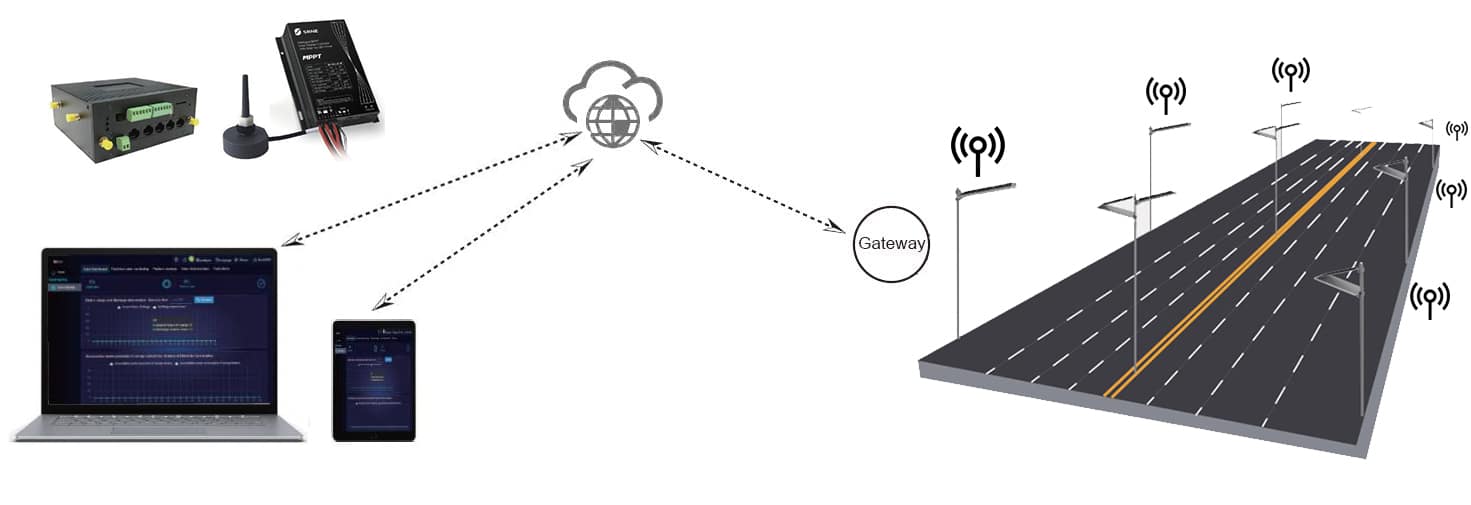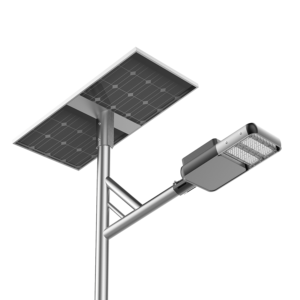Smart solar street light – built-in system or wireless control
Introduction
Solar street lights play a crucial role in municipal street lighting, offering a sustainable alternative to traditional AC LED street lights by harnessing solar energy. The appeal of solar street lights lies in their ability to operate without consuming electricity from the grid, conserving valuable resources. With urbanization and population growth driving increased demand for electricity, particularly in cities, there’s a heightened focus on renewable energy sources like solar, wind, and tidal power.
Solar street lights operate by converting sunlight into electrical energy using solar panels, which is then stored in batteries. During nighttime, this stored energy powers the street lights, illuminating roads without relying on grid electricity. However, continuous full-night lighting can quickly deplete battery reserves, necessitating larger solar panels and batteries to ensure sustained illumination throughout the night. This approach helps prevent hazardous dark environments for pedestrians and drivers, albeit at a higher cost.
To enhance energy efficiency further, smart solar street lights integrate intelligent control systems. These systems employ techniques like timer dimming, motion sensors, and wireless controls to manage street light output at night. By automatically adjusting lighting levels based on ambient light and road usage, smart solar street lights optimize energy consumption and reduce strain on social resources, promoting greener and more environmentally friendly lighting solutions. In this article, we will delve into the application and benefits of smart control systems in solar street lights.

Benefits of smart solar street light
Reasonable use of lighting to reduce light pollution:
Smart solar street lights are designed to provide lighting when necessary, automatically dimming or turning off during periods of reduced traffic at night, and gradually increasing brightness in the early morning as activity picks up in the city. This intelligent control not only ensures adequate illumination when needed but also minimizes unnecessary light pollution during low-traffic hours, thereby reducing the environmental impact of solar street lighting.
Extension of street lamp and battery lifespan:
By implementing lighting controls, smart solar street lights operate at reduced power levels, which is beneficial for both the longevity of LEDs and power supplies. This approach reduces heat accumulation and extends the lifespan of the lamps. Moreover, operating at reduced power levels reduces battery consumption, preserving battery life. Battery lifespan is closely related to the number of charge-discharge cycles and the depth of discharge. Operating at reduced power levels minimizes deep discharges, significantly contributing to prolonging battery life.
Reduction of solar street light configuration to lower costs:
Smart control systems substantially reduce power consumption during the operation cycle of solar street lighting systems. As a result, the overall system configuration requires fewer batteries and solar panels compared to traditional setups. This reduction in component requirements leads to significant cost savings, considering that batteries and solar panels typically account for approximately 80% of the total cost of a solar street light system.
Green and environmentally friendly with promising development prospects:
Although the initial construction cost of solar street lights is higher than that of standard AC street lights, smart control systems help optimize system configurations, thereby controlling costs effectively. As energy costs continue to rise, the payback period for solar street lights is becoming shorter, making them economically viable over time. Additionally, wireless control capabilities enable effective monitoring of solar street lights, promoting their widespread adoption as a green and environmentally friendly solution for municipal lighting.
Smart solar street lights with built-in control systems:
Standard solar street lights operate autonomously based on ambient light levels without additional control methods. Solar controllers monitor solar panel output voltage (or charging voltage) to determine when to turn the lights on or off based on sunlight brightness. However, for more intelligent management, Aimlux advocates using built-in smart solar controllers or sensor-based systems, which can be categorized into three main types:
- Solar street light in sunny day
In this situation, solar street lights will work from dusk to dawn. Through the built-in functions of the controller, we can set time-based dimming to achieve better energy saving. The basis is that after midnight, there will be fewer vehicles and pedestrians, and the illuminance can be lower accordingly according to lighting requirements. From the lighting dimming curve in the figure below, we can see that the power consumption of the battery is significantly reduced in this mode. Then the saved power can be stored for rainy days. In this mode, the dimming curve can be set to 4-5 gradients. For example: the light is 80% on within 1 hour after turning on the light, the light is 100% on for the rest of the first half of the night. And the light is 30% on from 0:00 to 4:00. In the morning, we can increase the brightness to 100% to welcome the morning 1 – 2 hours of small rush hour traffic.

Solar street lights charge their batteries during the day using solar panels. However, during overcast or rainy days, solar street lights may not function effectively, failing to convert solar energy into direct current and store it in the batteries. This inevitably leads to a shortened lighting duration at night or even a complete inability to provide illumination. To address the challenge of low solar energy conversion rates and nighttime power supply interruptions due to rainy weather, solar street lights are designed with intentionally increased capacities of solar panels and batteries to store energy. They aim to store as much electricity as possible during sunny days for use during inclement weather conditions. However, adopting this solution significantly increases the cost of solar street lights. Is there an appropriate solution to this?
Intelligent solar control is the prevailing solution for solar controllers. It can automatically adjust the load power (street lamp power) based on battery capacity. When used in conjunction with time-based dimming, the system selects the appropriate output power between the automatically adjusted power and user-defined settings. For instance, if the battery capacity falls below 40%, the intelligent controller deems 60% to be the appropriate load power. If the user sets the load power to 100% at this time, the final output will be 60%. Conversely, setting the load power to 20% results in a final output of 20% for the solar street light.

In the first two solar street light solutions, adjusting the output of solar street lights is primarily achieved through timed dimming and controller monitoring of battery capacity. They cannot adjust the output of the street lights based on real-time traffic usage. However, solar street lights equipped with motion sensors can detect movement or pedestrians within their range. When motion is detected by the motion sensor, it sends a signal (typically a 0-10V dimming signal) to the LED driver or controller, allowing them to increase the lamp’s power to meet the needs of pedestrians or drivers. When the motion sensor does not detect any movement or pedestrians, it sends a signal of 5V, 3V, or lower (0V), which requires the lamp to operate at 50%, 30%, or even completely shut off. By installing motion sensors, we can effectively adjust light output and save battery power. This makes solar street lights more intelligent and environmentally friendly, while reducing the cost of the fixtures.

Smart solar street light with wireless control
Wireless control is another intelligent control method for smart solar street lights. We previously detailed Zigbee and LoRa wireless control methods in smart street light control, which are almost identical to the wireless control methods used in solar street lights. This is a primary method to reduce public energy consumption while enabling easy management of individual fixtures and entire public lighting systems.
Moreover, smart solar street lights with wireless control systems can integrate Internet of Things (IoT) technology, allowing users to monitor and control solar street light systems and other city sensors online where internet is available. The wireless control system for solar street lights can achieve the following key functions:
- Remote on/off control: After connecting the solar controller with a wireless module, it can receive on/off commands from a remote server to control the operation of the lights.
- Adjusting brightness or switching under special circumstances: For example, turning on lights earlier during stormy weather to provide illumination, or increasing brightness for special occasions (e.g., important festivals) to meet pedestrian and vehicular lighting needs.
- Setting different scene modes: For instance, configuring different dimming curves based on seasons. Different dimming curves can be selected according to the season.
- Summer dimming configuration: 100% illumination for 4 hours after dusk (19:00-23:00), then 80% illumination for 2 hours (23:00-01:00), followed by 50% illumination for 3 hours (01:00-04:00), and finally, gradual increase to 80% illumination for 2 hours (04:00-06:00).
- Winter dimming configuration: 60% illumination for 2 hours after dusk (17:00-19:00), then 80% illumination for 4 hours (19:00-23:00), followed by 30% illumination for 3 hours (01:00-04:00), and finally, 50% illumination for 2 hours before dawn (04:00-06:00).
Real-time monitoring of street light status: Through the wireless system, we can monitor the status of street lights in real time on the platform, including occurrences of faults, fault locations, and reasons for failures. Road managers can promptly provide feedback to maintenance personnel for appropriate repairs.






